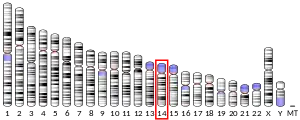A-kinase anchor protein 6 is an enzyme that in humans is encoded by the AKAP6 gene.[5][6][7]
The A-kinase anchor proteins (AKAPs) are a group of structurally diverse proteins, which have the common function of binding to the regulatory subunit of protein kinase A (PKA) and confining the holoenzyme to discrete locations within the cell. This gene encodes a member of the AKAP family. The encoded protein is highly expressed in various brain regions and cardiac and skeletal muscle. It is specifically localized to the sarcoplasmic reticulum and nuclear membrane, and is involved in anchoring PKA to the nuclear membrane or sarcoplasmic reticulum.[7]
Interactions
AKAP6 has been shown to interact with Ryanodine receptor 2[8][9] and PDE4D3.[10]
References
- 1 2 3 GRCh38: Ensembl release 89: ENSG00000151320 - Ensembl, May 2017
- 1 2 3 GRCm38: Ensembl release 89: ENSMUSG00000061603 - Ensembl, May 2017
- ↑ "Human PubMed Reference:". National Center for Biotechnology Information, U.S. National Library of Medicine.
- ↑ "Mouse PubMed Reference:". National Center for Biotechnology Information, U.S. National Library of Medicine.
- ↑ McCartney S, Little BM, Langeberg LK, Scott JD (May 1995). "Cloning and characterization of A-kinase anchor protein 100 (AKAP100). A protein that targets A-kinase to the sarcoplasmic reticulum". J Biol Chem. 270 (16): 9327–33. doi:10.1074/jbc.270.16.9327. PMID 7721854.
- ↑ Nagase T, Ishikawa K, Nakajima D, Ohira M, Seki N, Miyajima N, Tanaka A, Kotani H, Nomura N, Ohara O (Sep 1997). "Prediction of the coding sequences of unidentified human genes. VII. The complete sequences of 100 new cDNA clones from brain which can code for large proteins in vitro". DNA Res. 4 (2): 141–50. doi:10.1093/dnares/4.2.141. PMID 9205841.
- 1 2 "Entrez Gene: AKAP6 A kinase (PRKA) anchor protein 6".
- ↑ Marx, S O; Reiken S; Hisamatsu Y; Jayaraman T; Burkhoff D; Rosemblit N; Marks A R (May 2000). "PKA phosphorylation dissociates FKBP12.6 from the calcium release channel (ryanodine receptor): defective regulation in failing hearts". Cell. UNITED STATES. 101 (4): 365–76. doi:10.1016/S0092-8674(00)80847-8. ISSN 0092-8674. PMID 10830164.
- ↑ Marx, S O; Reiken S; Hisamatsu Y; Gaburjakova M; Gaburjakova J; Yang Y M; Rosemblit N; Marks A R (May 2001). "Phosphorylation-dependent regulation of ryanodine receptors: a novel role for leucine/isoleucine zippers". J. Cell Biol. United States. 153 (4): 699–708. doi:10.1083/jcb.153.4.699. ISSN 0021-9525. PMC 2192391. PMID 11352932.
- ↑ Dodge, K L; Khouangsathiene S; Kapiloff M S; Mouton R; Hill E V; Houslay M D; Langeberg L K; Scott J D (April 2001). "mAKAP assembles a protein kinase A/PDE4 phosphodiesterase cAMP signaling module". EMBO J. England. 20 (8): 1921–30. doi:10.1093/emboj/20.8.1921. ISSN 0261-4189. PMC 125429. PMID 11296225.
External links
- Human AKAP6 genome location and AKAP6 gene details page in the UCSC Genome Browser.
Further reading
- Lester LB, Scott JD (1997). "Anchoring and scaffold proteins for kinases and phosphatases". Recent Prog. Horm. Res. 52: 409–29, discussion 429–30. PMID 9238861.
- Michel JJ, Scott JD (2002). "AKAP mediated signal transduction". Annu. Rev. Pharmacol. Toxicol. 42: 235–57. doi:10.1146/annurev.pharmtox.42.083101.135801. PMID 11807172.
- Nakajima D, Okazaki N, Yamakawa H, et al. (2003). "Construction of expression-ready cDNA clones for KIAA genes: manual curation of 330 KIAA cDNA clones". DNA Res. 9 (3): 99–106. doi:10.1093/dnares/9.3.99. PMID 12168954.
- Kapiloff MS, Schillace RV, Westphal AM, Scott JD (1999). "mAKAP: an A-kinase anchoring protein targeted to the nuclear membrane of differentiated myocytes". J. Cell Sci. 112 (16): 2725–36. doi:10.1242/jcs.112.16.2725. PMID 10413680.
- Marx SO, Reiken S, Hisamatsu Y, et al. (2000). "PKA phosphorylation dissociates FKBP12.6 from the calcium release channel (ryanodine receptor): defective regulation in failing hearts". Cell. 101 (4): 365–76. doi:10.1016/S0092-8674(00)80847-8. PMID 10830164.
- Dodge KL, Khouangsathiene S, Kapiloff MS, et al. (2001). "mAKAP assembles a protein kinase A/PDE4 phosphodiesterase cAMP signaling module". EMBO J. 20 (8): 1921–30. doi:10.1093/emboj/20.8.1921. PMC 125429. PMID 11296225.
- Marx SO, Reiken S, Hisamatsu Y, et al. (2001). "Phosphorylation-dependent regulation of ryanodine receptors: a novel role for leucine/isoleucine zippers". J. Cell Biol. 153 (4): 699–708. doi:10.1083/jcb.153.4.699. PMC 2192391. PMID 11352932.
- Strausberg RL, Feingold EA, Grouse LH, et al. (2003). "Generation and initial analysis of more than 15,000 full-length human and mouse cDNA sequences". Proc. Natl. Acad. Sci. U.S.A. 99 (26): 16899–903. Bibcode:2002PNAS...9916899M. doi:10.1073/pnas.242603899. PMC 139241. PMID 12477932.
- Schulze DH, Muqhal M, Lederer WJ, Ruknudin AM (2003). "Sodium/calcium exchanger (NCX1) macromolecular complex". J. Biol. Chem. 278 (31): 28849–55. doi:10.1074/jbc.M300754200. PMID 12754202.
- Ota T, Suzuki Y, Nishikawa T, et al. (2004). "Complete sequencing and characterization of 21,243 full-length human cDNAs". Nat. Genet. 36 (1): 40–5. doi:10.1038/ng1285. PMID 14702039.
This article is issued from Wikipedia. The text is licensed under Creative Commons - Attribution - Sharealike. Additional terms may apply for the media files.



